Introduction: Why Learning Styles Matter
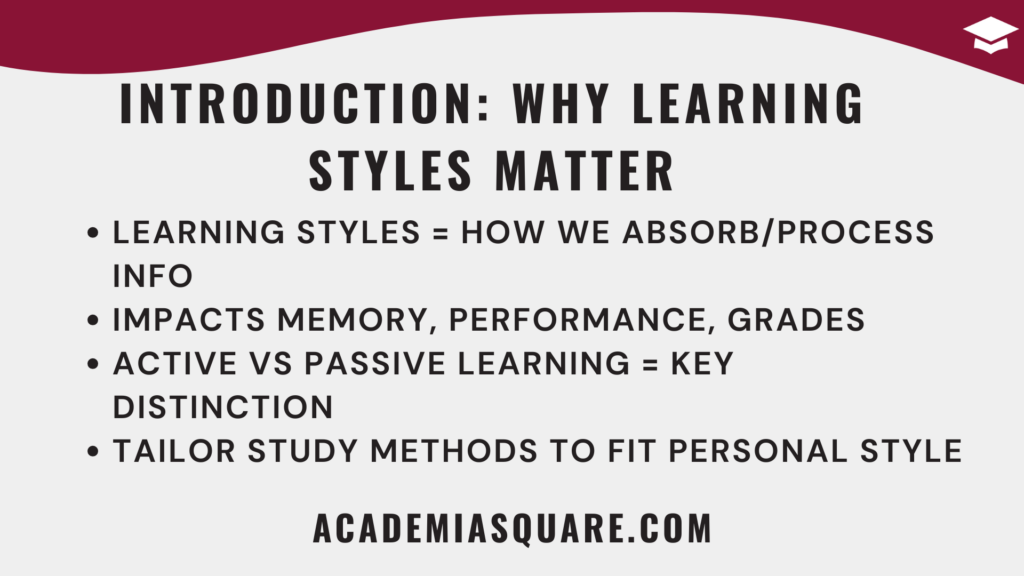
In the journey of education, understanding how we learn can be just as important as what we learn. While many students focus solely on memorizing facts or completing assignments, few take the time to reflect on their learning styles—and that can make a big difference. Knowing whether you learn better through active or passive methods can help you study smarter, not harder.
The concept of “active vs passive learning” has become a hot topic in both school and college environments. It refers to two different approaches to how students engage with educational material. One involves doing, discussing, and reflecting. The other involves receiving and absorbing information. Both have their place, but using them strategically can be the key to getting better grades and retaining information longer.
This blog is designed to help students and educators alike understand these two styles, so they can optimize learning sessions, increase engagement, and improve academic results.
What Is a Learning Style and Why Should You Care?
A learning style refers to the general approach a person takes to acquire, process, and retain knowledge. While no two people learn in exactly the same way, recognizing common patterns can guide students toward strategies that actually work for them. For example, some students perform better when they actively participate in class discussions, while others absorb more through listening to lectures or reading notes.
According to educational research, mismatching teaching methods with student learning styles can result in lower retention and engagement. That’s why being aware of the differences between active and passive learning is not just a theoretical concern—it’s a practical one.
Active vs Passive Learning: Why the Distinction Matters
Understanding the difference between active and passive learning can be a game-changer. Active learning involves the learner in the process—through questioning, collaboration, or applying concepts. Passive learning, on the other hand, usually involves listening or reading without interaction. Here’s a simplified breakdown:
- Active Learning: Hands-on activities, peer discussion, group work, problem-solving, practice tests
- Passive Learning: Listening to lectures, reading textbooks, watching videos, copying notes
Each method has its strengths. For example, passive learning can be useful for absorbing large volumes of information quickly. But if students want to deepen understanding or develop critical thinking skills, active learning is often more effective.
How Learning Style Impacts Your Grades
Most students want to know how to get better grades, and this is where understanding learning styles comes in. Research shows that students who engage in active learning are more likely to retain information and perform better in assessments. A study from the Proceedings of the National Academy of Sciences found that active learning increased exam performance by about 6% on average compared to traditional passive lectures.
That means if you’re struggling with certain subjects, switching to a more active approach—like doing practice quizzes or teaching someone else—could give your GPA the boost it needs. Likewise, passive learning can still be effective if paired with active recall strategies or reflection exercises.
Why Schools and Colleges Are Shifting Toward Active Learning
Educators are increasingly aware that the traditional lecture format doesn’t suit every learner. That’s why many schools and universities are adopting more interactive teaching techniques. Flipped classrooms, peer instruction, and problem-based learning are examples of methods that favor active over passive approaches.
This shift reflects a growing recognition that active learning isn’t just a trendy term—it’s backed by science. By focusing on deeper engagement, schools can help students not only learn better but also enjoy the process more. And for students, this awareness opens the door to smarter study choices and, ultimately, better results.
Defining Active vs Passive Learning
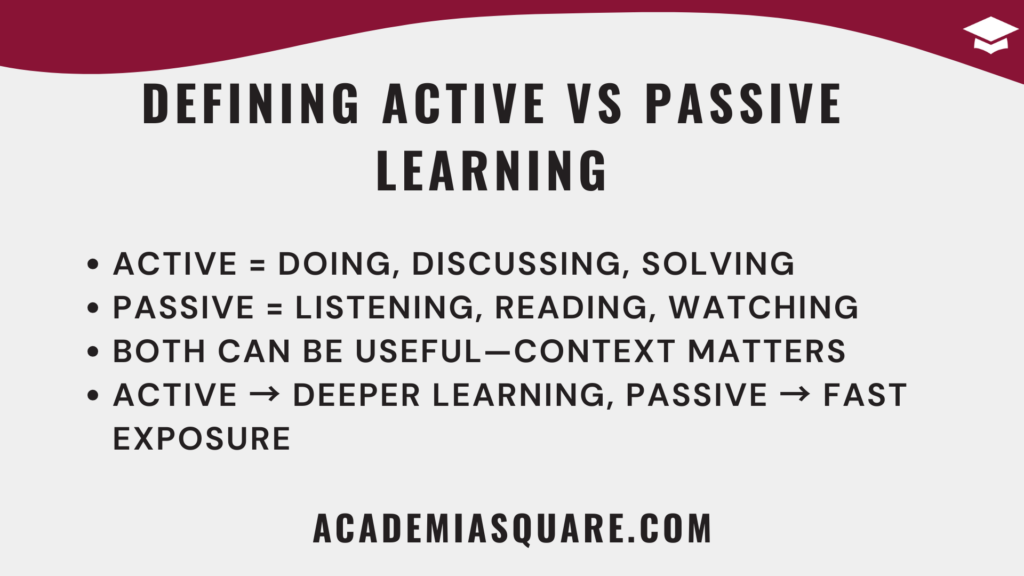
To understand how to learn better, you first need to understand what active vs passive learning actually means. These terms are often used in education, but they’re rarely explained with enough depth. At the core, they refer to how much mental and physical effort the learner puts into the learning process.
Active learning is any learning activity in which the student is directly involved in the process. This can include analyzing a case study, participating in a discussion, solving a problem, or even teaching someone else. Passive learning, by contrast, typically involves receiving information—like listening to a lecture or reading a textbook—without direct interaction or immediate application.
Neither approach is inherently bad. In fact, most effective education combines both. However, knowing when and how to use each can help you become a more efficient, successful student.
What Counts as Active Learning?
Active learning strategies engage students cognitively, emotionally, and sometimes physically. Instead of simply sitting and absorbing, you’re asked to think, solve, explain, or collaborate. This kind of engagement increases your ability to retain and apply information, which is essential for complex subjects or long-term retention.
- Group discussions or debates
- Hands-on experiments or simulations
- Concept mapping or summarizing in your own words
- Teaching the material to someone else
- Practice tests and spaced repetition
These techniques promote deep learning, helping you make connections between ideas rather than just memorize them. They’re especially useful in higher education but can be adapted for school as well.
What Counts as Passive Learning?
In passive learning, the student is usually a recipient rather than an active participant. While this may sound less effective, it’s actually a necessary part of the learning process, especially when first being introduced to new information. The key is to follow it up with active engagement.
- Listening to a lecture without asking questions
- Reading textbooks or academic articles silently
- Watching videos without taking notes or reflecting
- Copying information from slides or a board
Passive learning is efficient for getting a lot of content quickly, but retention tends to be lower if it’s not followed by active techniques like reviewing, quizzing, or discussing.
Combining Both for Maximum Effect
Most successful students use a mix of both learning styles. You might start with a passive strategy—like reading a chapter—then reinforce the material actively by writing a summary, teaching it to a classmate, or testing yourself. This two-step approach ensures both exposure and understanding.
Think of passive learning as the input and active learning as the output. Together, they complete the loop of deep, effective learning that leads to better grades and stronger academic performance.
Historical Evolution of Learning Methods
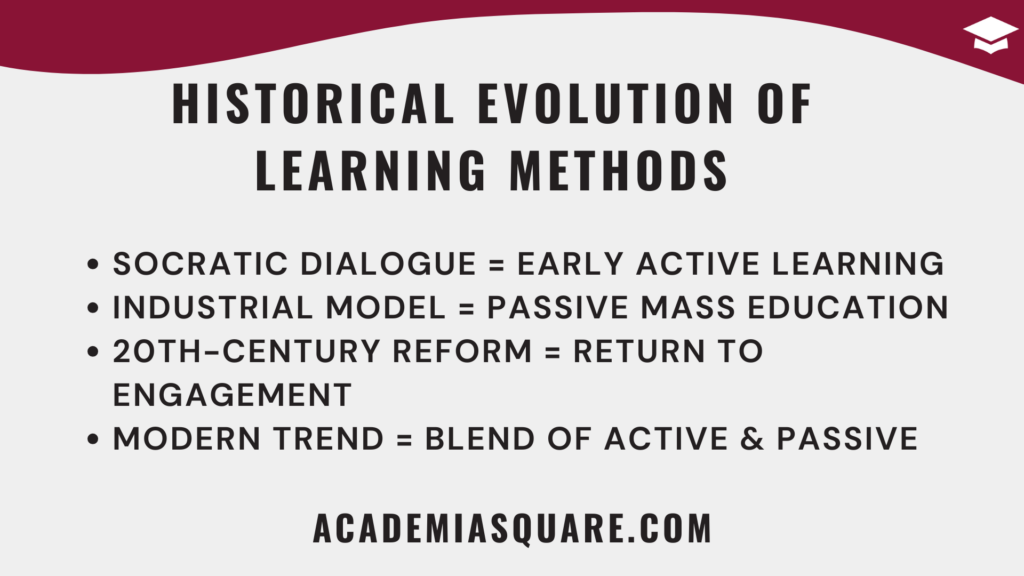
The divide between active and passive learning isn’t new—it’s been debated for centuries. From ancient times to modern classrooms, how students are expected to engage with information has evolved significantly. Understanding this evolution helps put today’s teaching methods into perspective, and it shows why active learning is gaining traction in schools and universities.
In early civilizations like Ancient Greece, learning was largely interactive. Socratic dialogue—a form of active learning where ideas were debated openly—was the foundation of education. Students were encouraged to question, reason, and argue. Fast-forward to the Industrial Revolution, and the focus shifted to mass education: large classrooms, strict discipline, and lecture-style teaching, all favoring passive absorption of content.
The Rise of Passive Learning Models
In the 19th and early 20th centuries, education systems around the world adopted the factory model of schooling. Students were lined up in rows, teachers stood at the front, and information flowed one way. This made it easier to educate large groups efficiently, but it prioritized memorization over critical thinking.
During this era, standardized testing also became the norm, reinforcing passive learning strategies like rote memorization and textbook reading. While this approach worked to some extent, it ignored the individuality of learning styles and suppressed engagement for many students.
Active Learning Makes a Comeback
By the late 20th century, educators began to realize that passive methods weren’t enough. Research started to show that students retained more, understood better, and developed critical thinking skills more effectively through active participation. This sparked a revival of interest in active learning strategies.
Studies published in journals like *Educational Psychologist* and *Cognition and Instruction* revealed that when students interact with material—by discussing, solving, or explaining—they form stronger mental connections. This led to new teaching practices like:
- Collaborative learning environments
- Project-based assignments
- Flipped classrooms where lectures are homework and class time is for application
- Case-based or problem-based learning in medical and business schools
Where Education Stands Today
Today, many educational systems are shifting toward active learning again, especially in college settings. Online platforms, blended classrooms, and adaptive learning technologies make it easier than ever to personalize instruction and engage students actively. Yet, passive learning still has its role, especially when students need initial exposure to new content or want to review on their own.
The challenge for modern education is not to choose between active or passive learning, but to find the right balance. The more educators and students understand this history, the better prepared they are to make informed decisions about how to teach and how to learn effectively—especially when the goal is improved performance and higher grades.
Cognitive Science Behind Learning Styles
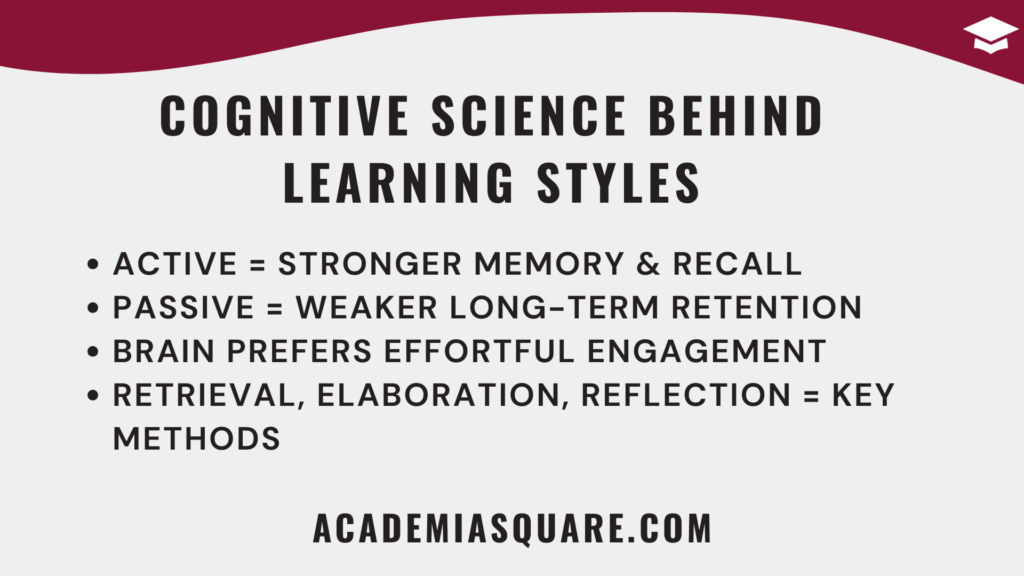
One of the most powerful ways to improve academic performance is to align your study habits with how your brain naturally processes and retains information. Cognitive science—an interdisciplinary field that includes psychology, neuroscience, and education—has a lot to say about active vs passive learning, and how each affects memory, understanding, and problem-solving ability.
When you engage actively with material, your brain forms stronger, more durable connections. In contrast, passive exposure often leads to what psychologists call “surface learning,” where information is easily forgotten because it hasn’t been processed deeply.
Why Active Learning Improves Memory and Understanding
Research shows that active learning promotes deep cognitive engagement. This is because it often involves elaboration (explaining concepts in your own words), generation (coming up with your own answers), and retrieval (bringing information to mind from memory). These are all high-effort mental activities, and your brain loves that.
According to a study published in *Science*, students who practiced retrieval through active methods like self-testing scored significantly higher than those who simply re-read material. This aligns with the principle of “desirable difficulty”—the idea that learning is more effective when it requires effort.
- Retrieval practice strengthens memory by forcing recall
- Elaboration helps link new knowledge to existing frameworks
- Peer teaching demands a full understanding before explanation
These are all active processes that contribute to long-term learning. If you’re aiming to get better grades, it’s hard to ignore how powerful these techniques can be.
The Neuroscience of Passive Learning
Passive learning, while not inherently bad, tends to engage the brain in lower-effort ways. When you’re simply listening or reading, you’re relying heavily on short-term memory. Without further engagement—such as summarizing or applying the material—your brain is likely to forget most of what you’ve learned within hours or days.
The “forgetting curve,” first identified by psychologist Hermann Ebbinghaus, shows how quickly information fades without reinforcement. Passive learning tends to ride the downward slope of this curve unless it’s paired with follow-up activities.
So while you might feel productive watching a lecture or highlighting a textbook, cognitive science reminds us that real learning happens when you go beyond consumption to interaction.
Matching Learning Strategies to Brain Function
To maximize your academic success, match your strategies to how your brain works. This doesn’t mean abandoning passive learning entirely. It means using it as a first step, and then applying active strategies to lock the information in place.
For example, read a chapter (passive), then teach the key ideas to a friend (active). Watch a video lecture (passive), then write your own quiz questions about it (active). These combined efforts respect your brain’s need for both initial exposure and deeper processing.
Understanding the cognitive science behind learning styles empowers you to choose methods that don’t just feel efficient—but actually are. If you’ve ever wondered why some techniques work better than others, now you know: your brain prefers effortful, meaningful engagement over passive intake.
Active vs Passive Learning in the Classroom
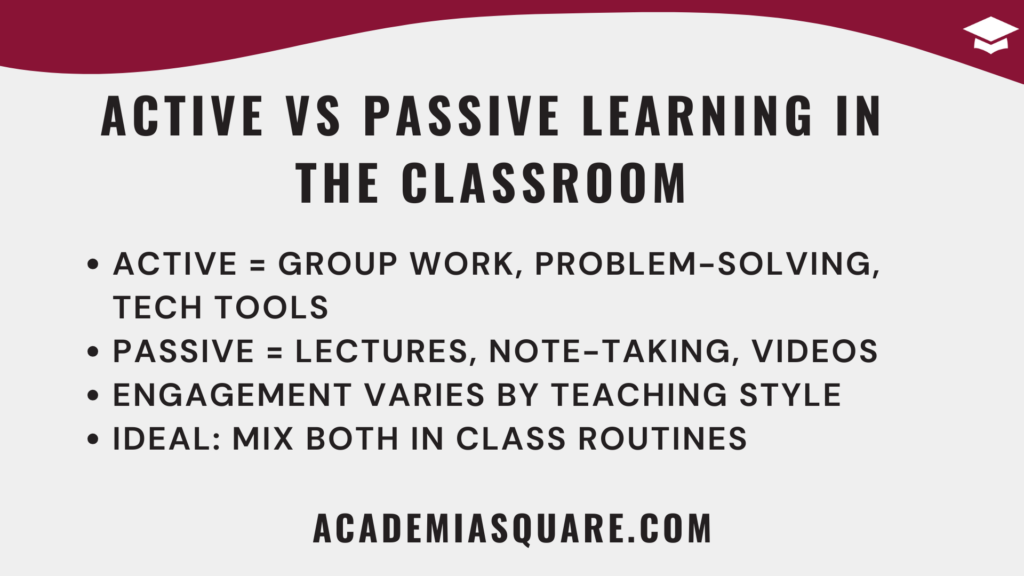
Classrooms are where the theory of learning styles meets real-world application. Whether you’re in middle school, high school, or college, how teachers structure their lessons—and how students respond—plays a major role in educational outcomes. Exploring the differences between active and passive learning in the classroom reveals how teaching style can either limit or amplify student engagement and academic success.
What Active Learning Looks Like in Practice
Active learning classrooms are dynamic. Instead of students sitting silently for an hour, they might be solving problems in groups, discussing questions, or engaging with technology-based tools. The teacher often acts more like a guide than a lecturer, prompting students to explore, reflect, and apply knowledge.
These classrooms often feature:
- Collaborative projects and group work
- Think-pair-share exercises and small group discussions
- Interactive technology like quizzes or polling apps
- Role-playing or simulations to apply concepts
According to research by the American Association for the Advancement of Science, such classrooms improve retention, reduce failure rates, and increase participation—particularly among underrepresented groups.
What Passive Learning Looks Like in the Classroom
In a passive learning environment, the teacher is the primary source of information, and students are expected to absorb it quietly. This is the traditional lecture model, and while it can be efficient for delivering large volumes of content, it often leads to lower levels of student interaction and engagement.
Features of passive classrooms include:
- Extended teacher lectures with minimal breaks for questions
- Note-taking without discussion or processing
- Few opportunities for feedback or clarification
Students in these settings may become disengaged, especially if the content is complex or unfamiliar. Yet, in some cases—like introducing a new topic or covering foundational facts—passive methods still serve a purpose.
Striking the Right Balance in the Classroom
Successful teachers often blend both approaches. They might start with a 10-minute lecture (passive), then move into a collaborative activity (active), and finish with a quiz or reflection session. This balance supports multiple learning styles and keeps students mentally involved throughout the class.
For students, knowing what type of classroom they’re in can help them choose supplemental strategies. If your class leans passive, you may need to add active learning on your own—by forming a study group or using flashcards and quizzes. If your class leans active, use those moments to clarify doubts and test your understanding in real time.
Ultimately, recognizing how active vs passive learning functions in the classroom helps both students and teachers make smarter choices. When everyone is more aware of how learning happens, the classroom becomes not just a place of instruction—but a space for real, lasting growth.
Benefits and Drawbacks of Active Learning
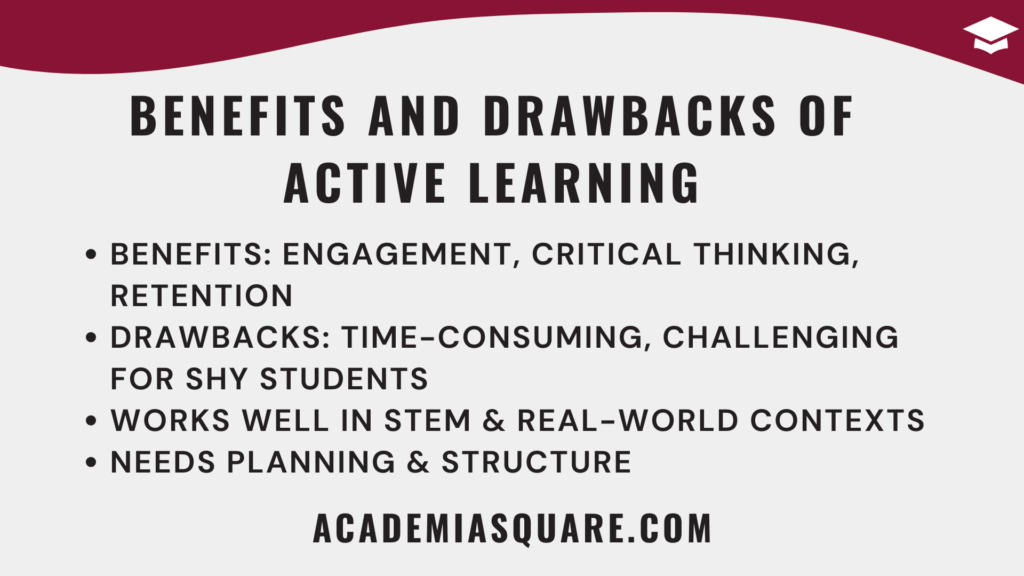
Active learning has emerged as a leading strategy in modern education, and for good reason. It encourages students to do more than just receive information—it challenges them to engage, question, and apply what they learn. But like any educational method, it’s not without its limitations. Understanding the benefits and drawbacks of active learning helps educators implement it more effectively, and students use it to their advantage.
Key Benefits of Active Learning
The most compelling argument in favor of active learning is its positive impact on academic performance. Numerous studies have confirmed that when students take a more hands-on, participatory approach to learning, they retain more information and perform better on assessments. The following are some standout benefits:
- Improved retention and understanding: Engaging with material actively strengthens memory and helps students make meaningful connections.
- Greater student engagement: Participation, discussion, and collaboration keep learners mentally and emotionally involved.
- Enhanced critical thinking skills: Activities like debates, case studies, and problem-solving promote deeper cognitive processing.
- Better preparation for real-world tasks: Active learning mirrors the type of problem-solving and communication skills needed in modern careers.
In one landmark meta-analysis published in *Proceedings of the National Academy of Sciences*, students in active learning environments had a 6% higher average exam score and were 1.5 times less likely to fail compared to those in traditional passive settings.
Drawbacks and Challenges of Active Learning
Despite its strengths, active learning does come with challenges. It requires more planning and flexibility, both for instructors and students. Teachers must design activities that align with learning goals, while students may need time to adjust to being more involved in class sessions.
- Requires more time: Active learning tasks like discussions or group work can take longer than passive lectures.
- Demands higher preparation: Both students and educators need to come to class ready to participate and think critically.
- Can be uncomfortable for introverts: Some students may feel anxious in participatory settings, especially in large groups.
- Risk of off-task behavior: In less-structured environments, some students may disengage or focus on unrelated topics.
These limitations don’t mean active learning should be avoided. Rather, they highlight the need for thoughtful implementation. For instance, mixing individual reflection with group activities can help introverted students feel more comfortable participating.
When Active Learning Works Best
Active learning tends to be most effective in subjects that require critical thinking, application, or discussion—like science, literature, and social studies. It’s particularly useful for helping students get better grades when understanding matters more than memorization.
In technical fields, too, such as math or engineering, active techniques like problem-based learning and coding labs allow students to practice what they learn in a practical context, improving both retention and skill development.
Knowing these strengths and limitations helps students and educators make strategic decisions about when and how to apply active learning methods most effectively.
Benefits and Drawbacks of Passive Learning
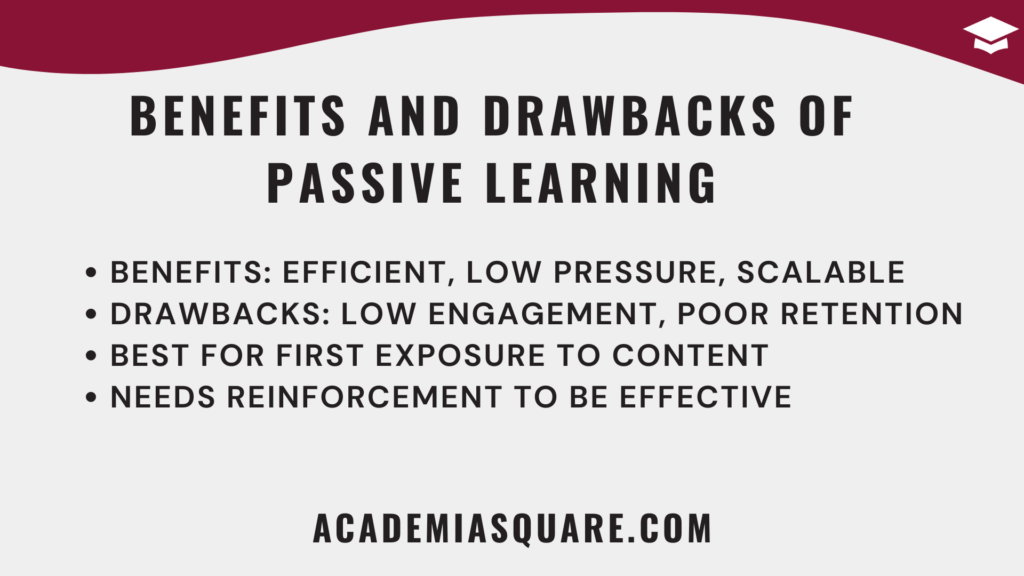
While active learning has taken center stage in modern education, passive learning remains a foundational part of the academic experience. Whether it’s listening to a lecture, reading a textbook, or watching an instructional video, passive learning still plays an important role—especially in the early stages of knowledge acquisition. Understanding its benefits and limitations helps students use it more strategically to support their academic goals.
Key Benefits of Passive Learning
Passive learning methods are often easier to implement and scale. For students just being introduced to a topic, passive methods offer structure, clarity, and a straightforward way to absorb large amounts of information efficiently. Key benefits include:
- Efficient content delivery: Lectures and reading can cover more material in less time.
- Good for foundational knowledge: Ideal for learning definitions, theories, and frameworks before applying them.
- Low-pressure environment: Students can take in information at their own pace, especially in self-guided reading or recorded lectures.
- Flexible and accessible: Pre-recorded videos, textbooks, and notes are available anytime, which supports diverse schedules and learning speeds.
These strengths make passive learning an effective starting point for deeper engagement. Many successful students begin with passive exposure and follow it with active strategies to reinforce what they’ve learned.
Drawbacks of Passive Learning
The main limitation of passive learning is its lack of interaction and engagement. This often leads to surface-level understanding, where students remember facts briefly but struggle to apply them in new contexts. Additional drawbacks include:
- Low retention rates: Without reinforcement or application, information is easily forgotten.
- Limited critical thinking: Students aren’t challenged to analyze or synthesize material actively.
- Risk of disengagement: Long lectures or reading sessions without breaks or interaction can lead to boredom or zoning out.
- Minimal feedback: Students rarely receive immediate correction or guidance during passive activities.
Because of these challenges, passive learning alone is rarely enough—especially for students aiming to improve performance or boost grades. It’s most effective when paired with active learning techniques that help internalize and apply information.
When Passive Learning Works Best
Passive methods are particularly useful when you’re being introduced to a new topic or need to absorb a wide range of facts quickly. For instance, reading a biology textbook chapter or watching a history documentary provides essential context before diving into more complex analysis.
In college, where class sizes can be large and course loads heavy, passive strategies like listening to a recorded lecture or skimming key concepts before an exam can help manage time and workload efficiently. Just remember that passive learning is the foundation—not the full structure—of academic success.
Used wisely, passive learning can support a strong educational strategy. But on its own, it may not be enough to achieve deep understanding or long-term retention. That’s why blending it with active techniques is often the smartest path forward.
Implementing Active Learning Strategies
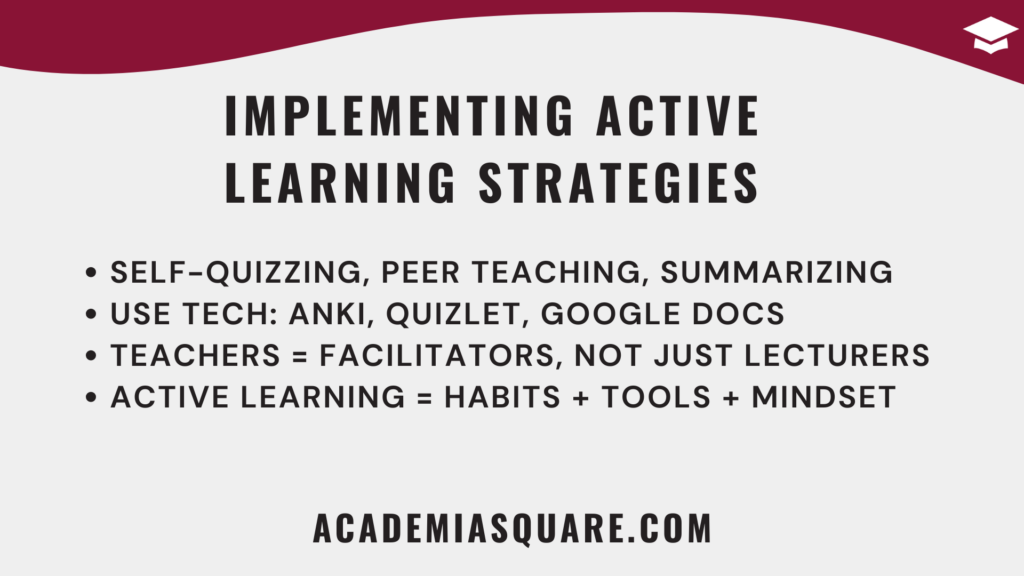
Now that we’ve explored the advantages of active learning, the next step is practical implementation. Many students and educators understand the concept, but they struggle with how to apply it consistently. Whether you’re in school or college, learning to use active learning strategies effectively can make a real difference in academic performance and long-term retention.
The key is to adopt methods that turn you into a participant in your own learning process. Instead of just passively consuming content, you’re actively engaging with it—by asking questions, solving problems, and testing your understanding in real time.
Easy Active Learning Strategies for Students
You don’t need fancy tools or major curriculum changes to use active learning. Many strategies are simple to apply and can be incorporated into daily study routines. Here are several proven techniques:
- Practice retrieval: Use flashcards or self-quizzing to recall information from memory.
- Teach someone else: Explaining a concept aloud forces you to clarify your understanding.
- Summarize material: After reading, write a short summary in your own words.
- Use spaced repetition: Review information over time instead of cramming.
- Ask questions: Interrogate the material with “why,” “how,” and “what if” questions.
These methods are research-backed and particularly useful for students wondering how to get better grades through smarter—not longer—study sessions.
Active Learning in the Classroom
Teachers can integrate active learning by rethinking how class time is used. Instead of delivering content passively, they can design tasks that encourage students to analyze, collaborate, and problem-solve. Popular classroom-based strategies include:
- Think-pair-share discussions
- Case studies or role-playing exercises
- Interactive polls and quizzes
- Problem-based or project-based learning
Instructors don’t have to abandon lectures altogether. Even brief activities—like pausing to ask a question or inviting a student to summarize a point—can introduce active elements and boost retention.
Technology-Enhanced Active Learning
Online tools and platforms make it easier than ever to apply active learning in both physical and virtual classrooms. Apps like Quizlet, Kahoot!, and Anki offer engaging ways to practice recall. Platforms like Padlet or Google Docs support collaborative writing and brainstorming.
For schools and colleges with access to learning management systems (LMS), integrated discussion boards, assignments, and quizzes can all be structured to support active participation.
By integrating these tools with intentional strategy, students and teachers can transform passive study sessions into powerful, engaging learning experiences.
Balancing Active and Passive Learning
While it’s tempting to choose sides in the active vs passive learning debate, the truth is that both approaches have value. The most effective learners—and educators—don’t rely exclusively on one or the other. Instead, they understand when to use each strategy to support different learning goals and contexts. Balance is key.
Why a Blended Approach Works Best
Every topic, task, or student may require a slightly different mix of learning methods. For example, it may make sense to begin with a passive strategy, like reading a chapter or watching a lecture, to gain foundational knowledge. Then, students can follow up with active techniques—like discussing the material in a group or completing application-based exercises—to reinforce understanding.
This cycle—passive input followed by active output—is supported by research in cognitive science and pedagogy. It maximizes retention, engagement, and long-term learning.
How to Combine Methods Effectively
To get the most out of both learning types, students and educators can try these combination tactics:
- Watch, then quiz: Follow a video lecture with a self-test to reinforce concepts.
- Read, then reflect: After reading a textbook, write a one-paragraph summary or journal entry.
- Lecture, then apply: Instructors can deliver short lectures, followed by small group activities to apply the material.
- Flip the classroom: Have students review content at home (passive), and use class time for activities (active).
This kind of thoughtful structuring allows each learning style to reinforce the other. The result is a more holistic educational experience that accommodates different types of learners.
When to Prioritize Active vs Passive Learning
While active learning is generally more effective for retention and skill-building, passive learning still has its place. Prioritize passive learning when:
- Introducing entirely new concepts or frameworks
- You need to quickly absorb a large volume of information
- Independent review or repetition is required
On the other hand, prioritize active learning when:
- You’re preparing for exams and want to reinforce material
- Concepts require deep understanding or application
- Collaborative or problem-solving tasks are involved
By recognizing the strengths and limitations of each approach, students and educators can design more effective learning experiences that support both comprehension and performance.
Case Studies: Success Stories in Active Learning
The theory behind active learning is compelling, but nothing demonstrates its value better than real-world examples. Across schools, universities, and even corporate training programs, active learning strategies have led to remarkable transformations in engagement, retention, and achievement. Here are several inspiring success stories that highlight how these methods work in practice.
University-Level Impact: STEM Courses
At the University of Colorado Boulder, introductory physics courses were redesigned to emphasize active engagement. Instead of long lectures, students worked in small groups, used clickers for in-class questions, and engaged in peer instruction. The result? A 50% drop in failure rates and a measurable improvement in conceptual understanding, according to published outcomes in *Physical Review Special Topics – Physics Education Research*.
This shows how even traditionally passive disciplines like physics can be reshaped to foster better learning outcomes.
High School Engagement Through Projects
In a Chicago public high school, teachers implemented a problem-based learning approach in a biology class. Students tackled real-world challenges like designing ecosystems or evaluating climate change scenarios. The shift resulted in higher test scores and increased attendance, with students reporting they felt more “connected” to the material and motivated to learn.
These results confirm that active learning isn’t just for colleges—it can radically improve engagement and performance in secondary education as well.
Medical Education: Peer Teaching
Medical schools have also embraced active methods. At Harvard Medical School, students are often required to teach each other as part of the curriculum. This peer-teaching approach ensures that students not only understand material deeply but can also communicate it clearly—critical for future physicians.
Peer instruction has been found to enhance both comprehension and confidence, particularly when dealing with complex material like anatomy and pharmacology.
Online Success: Blended and Flipped Classrooms
Georgia Tech introduced a blended model for its computer science courses, combining online lectures (passive) with in-person coding labs (active). The program saw higher completion rates and stronger final project quality compared to fully lecture-based courses. It also gave students greater autonomy, which they cited as a major motivator.
This example highlights how active and passive learning can be seamlessly blended—even in digital spaces—to create richer, more effective learning environments.
These case studies provide concrete evidence that when students are active participants in their education, they learn more, stay engaged longer, and perform better. Whether you’re a teacher designing a lesson or a student aiming to get better grades, the success stories above offer valuable lessons worth applying.
Adapting Learning Styles for Online Education
As more students shift to online learning—either partially or fully—the question becomes: how do active vs passive learning work in digital environments? Online education brings unique challenges and opportunities, particularly when it comes to engagement and retention. But with the right strategies, both active and passive learning styles can be effectively adapted to virtual classrooms.
Whether you’re attending high school virtually, enrolled in an online college course, or using e-learning platforms for self-study, your learning style still matters. The format may change, but the principles of deep engagement, active recall, and structured input remain essential for success.
Common Passive Learning Habits in Online Settings
Online learning environments often default to passive modes—pre-recorded lectures, reading assignments, or watching tutorial videos. These tools are useful, especially for learning at your own pace, but they also carry the same risks as passive learning in traditional classrooms: low retention and limited engagement.
- Watching videos without interaction or note-taking
- Reading online textbooks without summarizing or questioning
- Attending webinars without active participation
To overcome these limitations, students need to convert these passive moments into active ones by applying the techniques discussed earlier—quizzing themselves, taking notes, or discussing the material with others.
Integrating Active Learning Online
Fortunately, technology offers powerful tools to make online learning more active. Instructors and students can leverage the following strategies:
- Interactive quizzes: Built into platforms like Coursera or Canvas to reinforce recall.
- Breakout rooms: Small group discussions during live sessions help maintain engagement.
- Collaborative documents: Google Docs or Padlet for real-time group projects and brainstorming.
- Discussion boards: Encouraging deeper analysis and peer-to-peer feedback.
Even asynchronous courses can be made more active by requiring reflection journals, peer feedback, or multimedia assignments that force students to synthesize information rather than just absorb it.
Tips for Students: How to Stay Active Online
If you’re learning online and wondering how to get better grades, apply these strategies to make your learning experience more active and effective:
- Pause videos frequently to take notes or summarize aloud.
- Use apps like Anki or Quizlet to turn notes into flashcards.
- Join or form virtual study groups via Zoom or Discord.
- Use dual screens or split-screen mode to take notes while watching lectures.
By combining self-awareness with the right tools, students can adapt their learning styles for online education—and thrive in any setting, digital or physical.
Conclusion: Empowering Students Through Informed Learning Choices
Understanding the difference between active and passive learning is more than just an academic exercise—it’s a practical strategy for improving educational outcomes. From cognitive science to real-world classroom applications, the evidence is clear: students who engage actively with material tend to retain more, understand better, and achieve higher grades.
But that doesn’t mean passive learning is obsolete. It still serves an essential role in building foundational knowledge, especially when time or structure is limited. The true power lies in knowing when and how to use each approach. This balance allows for more flexible, personalized learning experiences—whether you’re preparing for a high school test or navigating a demanding college course load.
Key Takeaways for Students and Educators
- Active learning promotes engagement, deeper understanding, and better retention.
- Passive learning supports efficiency and content exposure but should be supplemented.
- Combining both methods leads to the most effective and personalized learning strategy.
- Online learning platforms can support both styles—if used intentionally.
- Being mindful of your learning style is one of the fastest ways to get better grades.
Whether you’re a student trying to improve your study habits or an educator designing your next lesson plan, understanding these learning styles equips you to make smarter, research-informed choices. Education isn’t one-size-fits-all—and when students are empowered to tailor their learning experience, the results speak for themselves.
Sources and Recommended Reading on Active vs Passive Learning
- Bonwell, Charles C. “What Is Meant by ‘Active Learning’?” Education, 2008.
- Freeman, Scott, et al. “Active Learning Increases Student Performance in Science, Engineering, and Mathematics.” Academic Medicine, 2014.
- Mayer, Richard E. “Higher Education Lectures: From Passive to Active Learning via Cognitive Load Theory.” Active Learning in Higher Education, 2017.
- McLaughlin, Jacqueline E., et al. “The Effects of Passive and Active Learning on Student Outcomes.” American Journal of Pharmaceutical Education, 2012.
- OpenStax. “The Motivated Learner.” College Success, 2019.
- Chi, Michelene T.H., et al. “Quality of Learning With an Active Versus Passive Motivational Set.” American Educational Research Journal, 1974.
- Miller, Richard I. “Progressive Educational Theory and Passive Learning Styles.” ERIC, 2018.
- Burr, Samuel E. “Active versus Passive Learning.” The Journal of Education, 1932.
- Academia Square. “SQ3R Method Guide: A Structured Approach to Reading and Learning.”


